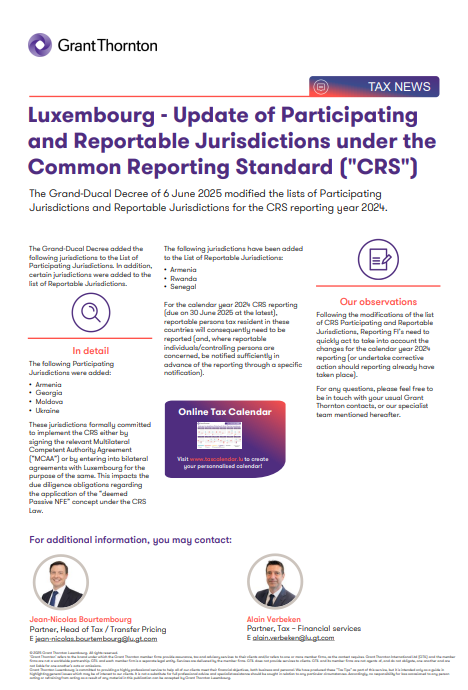
Luxembourg’s 2023–2028 Coalition Agreement and Tax Measures
Following the legislative elections in October 2023, the Luxembourg government unveiled its 2023–2028 coalition agreement, outlining initiatives to enhance the country’s economic competitiveness. The agreement places particular emphasis on the financial sector, with key tax reforms designed to foster sustainable growth and reinforce Luxembourg’s status as a leading international financial center over the next five years.
As part of this strategy, the government introduced its first major tax reform package, titled “Relief Package. Unity. Future. For Everyone.” Drafted in July 2024, approved by Parliament on 11 December 2024, and effective from 1 January 2025, this package laid the groundwork for broader tax reform. For some details, please refer to our previous publication: Newsflash Payroll 2024 | Grant Thornton Luxembourg.
Building on this momentum, Bill of Law No. 8590 was presented on 24 July 2025 and is currently under parliamentary review. The Bill aims to clarify, modernise, and expand the existing carried interest regime, providing targeted support to Luxembourg’s investment fund industry and enhancing its attractiveness for fund managers and investment professionals. The new regime is expected to apply from the 2026 tax year onward.
Towards a Modern, Competitive, and Clear Carried Interest Regime
The original carried interest regime, introduced in 2013 through the Alternative Investment Fund Managers (AIFM) Law, established a foundational tax treatment and included temporary incentives for fund managers relocating to Luxembourg between 2013 and 2018. However, it had limitations in scope and applicability, particularly regarding the types of income covered and the beneficiaries. It did not fully reflect the diversity of today’s fund remuneration structures or common practices like deal-by-deal carry distributions.
The new regime addresses these shortcomings by broadening its scope to encompass all forms of income tied to an AIF’s outperformance. It applies widely to all individuals involved in fund management, whether directly or indirectly, and removes previous restrictions requiring full investor reimbursement before carried interest payments. This added flexibility better aligns tax treatment with real-world fund economics and investor expectations.
Technical Overview of the New Carried Interest Regime
The updated regime extends carried interest beyond capital gains to include any right to participate in an AIF’s outperformance, such as performance fees or success-linked bonuses. It applies to all individuals managing or employed by entities managing AIFs, thereby ensuring comprehensive coverage, including advisors and independent directors.
A key innovation is the removal of the requirement that AIF investors be fully reimbursed before carried interest payments can be made. This change legitimises deal-by-deal carry models commonly used in private equity, aligning tax rules with industry practice.
The regime distinguishes two categories of carried interest, each subject to specific tax treatment:
- Contractual Carried Interest
Contractual carried interest refers to carry rights granted under a contractual arrangement that does not require the recipient to hold any equity stake in the AIF. Typically paid once a hurdle rate is achieved, this income is classified as extraordinary income and benefits from preferential taxation. It is taxed at 1/4 of the recipient’s regular income tax rate, resulting in an effective tax rate not exceeding 12%.
This favorable rate reflects the incentive nature of carried interest and supports Luxembourg’s ability to attract and retain talent. The absence of equity participation requirements also offers flexibility for compensation structures, particularly when direct equity ownership is impractical or undesired.
- Investment-Linked Carried Interest
Investment-linked carried interest arises when the holder directly co-invests in the AIF’s equity or capital. Taxation of such carried interest depends on both the holding period and the ownership level.
- Returns from the co-investment itself are subject to the standard income tax rate.
- Additional income attributable to carried interest enjoys a tiered tax treatment: if held for less than six months, it is taxed at 1/4 of the regular tax rate, similar to contractual carried interest.
If held for more than six months, and the individual holds no more than 10% of the share capital, the additional income is fully exempt from tax. This exemption incentivizes long-term investment and sustained engagement in fund equity.
Importantly, these tax rules apply regardless of the legal form of the carried interest issuer, ensuring consistent treatment whether the AIF is tax transparent or opaque. This structural neutrality eliminates uncertainties and guarantees that tax treatment is determined by the economic substance of the arrangement rather than its legal form.
Contact Us
If you have any questions or require further guidance on how the new carried interest regime may impact you or your clients, please do not hesitate to contact our Tax Advisory team.


